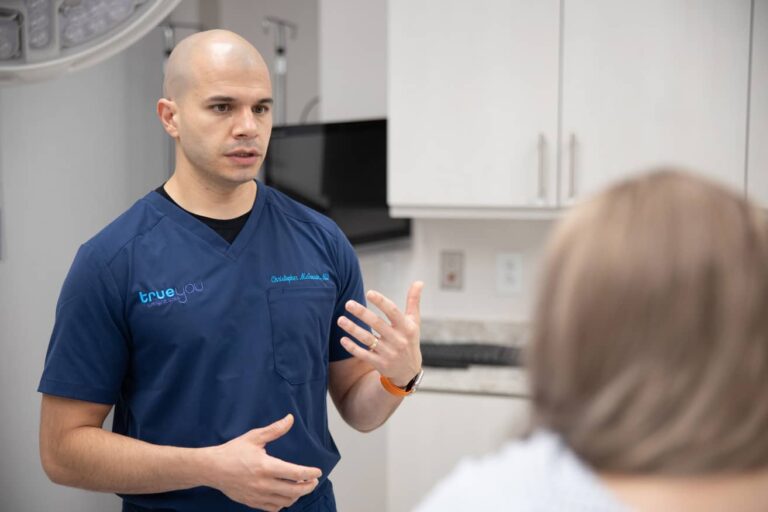Bariatric surgery is a safe and effective option for the treatment of obesity, offering significant long-term weight loss that improves a variety of obesity-related conditions, including type 2 diabetes, high blood pressure, sleep apnea, high cholesterol, and more.
However, some patients will experience weight recurrence – approximately one in five, to be exact – regaining their excess body weight within the first several years after bariatric surgery due to lifestyle or anatomical changes. When this happens, a revision procedure may help patients reclaim control over their weight loss and recommit to a healthy lifestyle to keep weight off for good.
Reasons for Bariatric Surgery Revision
Weight Recurrence
Obesity is a chronic, relapsing condition; weight loss surgeries are an excellent treatment option, but they’re not a cure. Maintaining weight loss and keeping obesity-related health conditions under control requires a lifetime of commitment. Unfortunately, many patients will experience new stressors or other lifestyle changes that impact their ability to follow their treatment plan. It’s not easy to stick to a treatment plan years and even decades after bariatric surgery; that’s why Eat Healthy Be Healthy provides a lifetime of support. Inevitably, life changes – new babies, new jobs, changes in relationship status, injuries, and mental health problems – can impact the way we eat and our ability to follow strict exercise routines.
New technologies
As providers perform more and more weight loss procedures, they learn more about what works and what doesn’t. This informs the development of new weight loss technologies and alters best practices over time. For example, Lap Bands — adjustable silicone bands placed around the stomach to restrict food intake — were very popular in previous decades, but these devices have fallen out of favor due to their significant long-term risks, including band slippage, hernias, and obstruction. Weight loss practitioners now recognize that many Lap Band patients require a revision procedure to maintain their results.
Anatomical changes
People’s bodies change over time. Doctors expect the stomach to gradually stretch after bariatric surgery, for example. It’s totally normal. Hormonal changes from fertility treatment, pregnancy, and menopause can impact weight loss. Injuries or health conditions affecting mobility, such as arthritis, can also curb results.
Side effects or complications
Some patients will develop or have worsening symptoms of Gastroesophageal Reflux Disease (GERD) after bariatric surgery. Complications such as leaks, strictures, and ulcers are uncommon, but do happen on occasion. Lastly, some patients may develop nutritional deficiencies as a result of altering the digestive system through bariatric surgery. All of these problems can typically be addressed with a revision procedure.
In order to examine the best revision options for you, it’s important to first understand the most common types of bariatric surgery.
Most Common Types of Bariatric Surgery
Gastric bypass
Gastric bypass surgery, also called Roux-en-Y gastric bypass, is one of the most commonly performed bariatric procedures in the world. In the procedure, a surgeon re-routes the digestive tract, cutting away a small portion of your stomach and sewing it into a gastric pouch. The surgeon disconnects the small intestines from the duodenum (the horseshoe-shaped organ that attaches the stomach to the small intestines) and attaches the gastric pouch to the remaining portion of the small intestines, bypassing the rest of the stomach and the duodenum. Those two organs are left in place, however, and re-attached to the other end of the small intestines to allow gastric juices to aid digestion of the smaller amount of food that now fits in the gastric pouch.
Sleeve gastrectomy
In a sleeve gastrectomy, a surgeon removes a large portion of the stomach, leaving behind a small, banana-shaped pouch that limits food intake. The pouch, or “sleeve”, remains connected to the duodenum as normal, but the majority of the stomach is removed permanently.
Gastric banding
Gastric banding, also called Lap Band surgery, places a restrictive silicone band around the stomach, leaving a small pouch at the top of the stomach that fills quickly, so you feel full after only consuming a small amount of food.
So, what’s the best option for revision surgery?
It depends. Revision surgery options are highly dependent on patients’ individual and unique circumstances, including the type of original bariatric surgery, how much weight they wish to lose, and what side effects they may be experiencing.
Non-surgical options for bariatric revision surgery
Eat Healthy Be Healthy offers endoscopic revision procedures for gastric sleeve and gastric bypass patients who need it. These non-surgical, minimally invasive, outpatient procedures restore the tightness of a gastric sleeve or gastric pouch to restrict food intake and help patients start losing weight again.
Our team of doctors is triple board-certified in internal medicine, gastroenterology, and obesity medicine and nationally recognized leaders in endobariatric weight loss procedures, including bariatric surgery revisions.
Dr. Lauren Donnangelo, Dr. Daniel Maselli, and Dr. Christopher McGowan have helped tens of thousands of patients from more than 45 states and 10 countries. They offer unrivaled expertise – in fact, Eat Healthy Be Healthy is the highest-volume bariatric endoscopy weight loss center in the United States.
Ongoing Support for Success
To ensure a bariatric surgery revision is successful in keeping excess weight off for good, Eat Healthy Be Healthy offers patients personalized and ongoing support, including 24/7 direct access to their physician through email, phone, or video chat.
If you’d like to learn more about a bariatric surgery revision procedure at Eat Healthy Be Healthy, please contact us to request a consultation.
